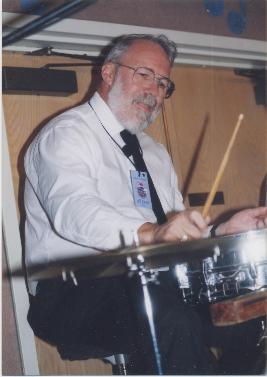Whither Traditional Jazz?
by Bert Thompson
on the stage are not young. It is equally obvious that the numbers of those attending and are
not increasing with each passing month—or even keeping constant. Thus some jazz some bands
have simply disappeared.
societies are teetering on the brink of insolvency, some festivals have already gone belly up,
and some bands have simply disappeared.
Does this mean that, indeed, we are witnessing the twilight of traditional jazz—at least here on
the West Coast? Maybe …. and maybe not.
Some thirty or so years ago, such a possibility was not on many minds. Jazz societies were
springing into being, bands were forming, festivals were being established—for the traditional
jazz lover, it was a golden age. By the eighties one could attend at least one festival any given
month in the western U.S., and one did not have to travel far to attend a jazz society meeting
any Sunday of each month.
What happened? The short answer is that people, both audience and band personnel, started
dying off and few replacements have been forthcoming.
Of course, it is not the first time that this phenomenon, this seeming or impending “death of
traditional jazz,” has occurred. The 1930’s saw the advent of swing music and big bands, which
did not bode well for traditional jazz at the time. King Oliver, for example, saw it and tried to
form a big band, as did Jelly Roll Morton. Neither was successful, and both died in poverty.
And traditional jazz seemed to die about the same time. But then it came back to life with the
“revival” of the 1940’s, bringing the young with it, only to sink once again into near oblivion
with the onslaught of rock ‘n’ roll in the 1960’s.
Then came the second revival of the 1970’s—but the difference was that the younger generation
did not come into the fold that time. And even now, some thirty odd years later, they have
still not tired of the two- or three-chord structure of most rock pieces or, even worse, the non-
musicality of rap. I should think that, in part at least, this is due to their being exposed to no
other kind of music. There is no traditional jazz to be heard on any radio station, other than
the occasional program on KCSM—certainly none on any commercial station. Likewise none is
to be seen or heard on television. Instead, the media offer the young nothing but the two R’s—
rock and rap—and the constant PR for rock bands and their tours, even though some of these
bands’ members are now in their sixties!
What to do about this lack of participation in traditional jazz activities by the younger
generations? While many of us have ignored the situation or denied there is a problem, others
have tried to answer the question, but their efforts have met with mixed success.
One potential solution that has been embraced by several jazz societies is to sponsor a youth
band (or two), this band being mentored by a musician, oftentimes not a school music teacher.
The band is allowed to play a set at the society’s monthly meeting, usually before the featured
band is to perform. What I have seen most often watching these bands is that invariably the
young people will play from charts, hardly raising their heads, and the minute their
performance is over, they and their families who have come along to “support” them make a
bee line for the door, never staying to hear the featured band. Few of the alumni of these
youth bands seem to have continued to play traditional jazz.
There are exceptions, of course, Bill Armstrong’s Churchill Street Jazz Band being one, many if
its alumni going on to form the core of the Royal Society Jazz Orchestra, and undoubtedly there
are others. This is not to denigrate the mentors of these bands, of which there are several all
around the country. As a retired teacher (not of music!), I take my hat off to them for
persisting in what must often be a thankless task. But I would not count the “sponsoring-a-
youth-band” approach a resounding success or a key means of preserving the
music. Part 1 - To be continued
|
|





